Diaphragm and Pelvic Floor Alignment
Growing up you probably had a parent or teacher say “sit up, shoulders back, stop slouching!” However, as well-intended as that was, the tendency is often to elevate the rib cage and thoracic spine rather than actually retracting your shoulder blades. If you looked at your spine from the side, you would see your mid-back would be behind your low back. Chest breathing is very common and is often caused first by the posture we are using and then can become a habit.
When in this alignment with the ribcage elevated, you will find it is not even possible to fill up the lower ribcage into the pelvis. This is because the diaphragm and pelvic floor need to be physically aligned with each other to function as intended. Think of the diaphragm as the roof and the pelvic floor at the floor and the piston action cannot occur when they are not aligned with one another.
This posture coupled with this breathing pattern over time can lead to excessive use of accessory muscles of inspiration which are located around the neck and shoulders. This can cause low-level tension in these areas that can lead to pain of varying degrees.
Another consequence of this alignment is low back pain. When the thoracic spine is consistently behind the lumbar spine without the natural core engagement the spine extensor muscles start over-firing to hold the body upright.
In PT with our treatment approach, we always start with screening for postural issues as well as assessing breathing mechanics to set the foundation for functional and safe ways to train the core. Oftentimes when we correct someone’s posture in the spine, their “chest up” posture is masking rounded shoulders and forward head postures. These other postural faults regularly need to be corrected as well and this can easily be done with corrective exercises in therapy.
About Empower Physical Therapy and Wellness -
Empower Physical Therapy and Wellness specializes in orthopedic PT to include sports injuries, joint replacements, spine injuries, as well as other joint issues and soft tissue injuries.
If you would like to get ahold of us, please fill out our Contact Us form or give us a call at 703-669-6100.



